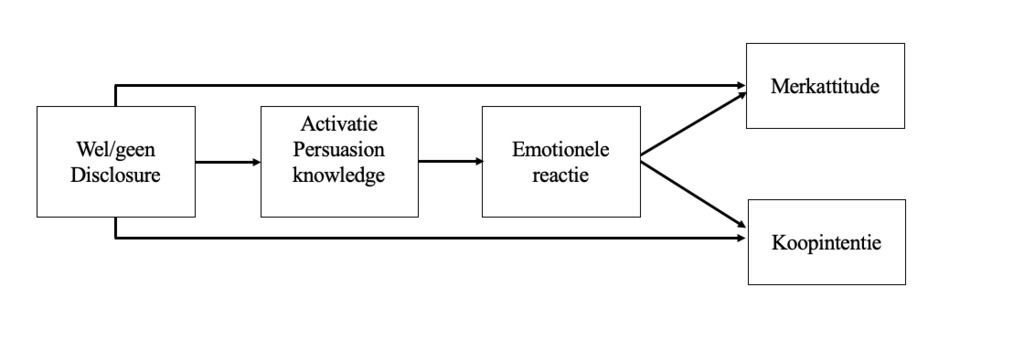Disclosure dilemma
Isabelle Leenders examined the influence of disclosures in influencer advertising on the brand attitudes and purchase intentions of young adults, mediated by their emotions and activation of persuasion knowledge.
Posted by
Published on
Tue 25 Jul. 2023
Topics
| Emotions | FaceReader Online | Facial Expression Analysis | Measure Emotions |

This blog post was written by Isabelle Leenders, who completed her Master's degree in Communication Sciences at Radboud University in Nijmegen, The Netherlands. The thesis was supervised by Paul Ketelaar, Assistant Professor in Communication Science and the Behavioural Science Institute (BSI) at Radboud University.
Unveiling the dilemma
In today's digital society, influencer marketing plays an increasingly prominent role in how young adults make purchasing decisions1,2. Considering this trend, stricter regulations have been introduced by governments, requiring the inclusion of disclosures for sponsored content3.
Through a disclosure (an advertising notification), consumers are informed about the commercial intent of an influencer's advertising message, and it helps them recognize the presence of advertising4,5. This can take the form of a hashtag, verbal mention, or description accompanying a post. Examples include "Advert," "#ad," or "paid promotion"6.
The use of disclosures creates a dilemma: on one hand, disclosures can create critical7, skeptical8 and negative emotional responses from young adults5,9. On the other hand, disclosures create trust in the influencer and transparency in the message10, which can lead to positive emotional responses from young adults11.
Towards understanding disclosures in influencer marketing
The study examined the impact of disclosures on purchase intention and brand attitude among young adults. The goal was to understand whether disclosing sponsored content through a disclosure influenced how young adults perceive a brand and whether they are inclined to make a purchase.
To better comprehend the effect, the study investigated whether the activation of persuasion knowledge and emotional response played a mediating role in this process. Figure 1 shows the research model of this study.

Figure 1: Research model
Measuring emotional response with FaceReader Online
The study was conducted among Dutch young adults between the ages of 18 and 30. A total of 89 participants were randomly assigned to two groups. Both groups were shown a video of a well-known Dutch vlogger.
This vlogger advertised a product from Airup, a well-known brand of water bottles among the target group. Participants in the experimental condition were presented with an auditory and visual disclosure following the product endorsement, while participants in the control condition did not receive any disclosure.
The auditory disclosure delivered by the influencer stated, “Air up is the sponsor of this video and the perfect sponsor for this video. Thank you, Air up, for sponsoring this video.” The textual disclosure appeared on screen only when the auditory disclosure was spoken (Figure 2).

Figure 2: Textual disclosure in the experimental condition
The study utilized a Qualtrics survey that seamlessly integrated with FaceReader Online. By combining the Qualtrics survey with FaceReader Online, the emotional response could be measured quickly and easily by the researcher.
Clear instructions were provided to the participants during the measurement, resulting in reliable data collection. The recorded data was promptly analyzed and presented clearly with graphs and figures.
FREE WHITE PAPER: FaceReader methodology
Download the free FaceReader methodology note to learn more about facial expression analysis theory.
- How FaceReader works
- More about the calibration
- Insight in quality of analysis & output
Revealing perspectives on the disclosure dilemma
Interestingly, no noticeable effect of disclosure (present/not present) was found on both brand attitude and purchase intention. This suggests that disclosing sponsored content may not have a direct influence on the brand attitude and purchase intentions of young adults.
Additionally, no noticeable effect was found of disclosures on the activation of persuasion knowledge or the emotional responses of young adults. Furthermore, these emotional responses did not have a noticeable effect on the purchase intention of young adults.
However, FaceReader Online did reveal a noticeable effect of emotions on brand attitude. More positive emotional responses were found to have a positive influence on how the brand was perceived. This indicates that creating positive emotions in influencer content can help promote a positive brand attitude.
How FaceReader Online may provide new insights
Although not proven the main goal of the research, this study emphasizes the importance of understanding consumers’ emotional responses to sponsored content, as it can influence their attitudes towards the promoted brand. Therefore, in future research on consumers’ emotional reactions to disclosures, FaceReader Online could be used more frequently.
This study has demonstrated that FaceReader Online is an effective method for measuring subtle and unconscious emotional responses in the context of influencer marketing. Particularly in experimental settings, FaceReader Online can be valuable because even when participants are aware of the camera and try to provide neutral responses, unconscious emotions can still influence brand attitude and how the brand was perceived behavior2.
Also read: Why you should use FaceReader Online for your human behavior research.
Uncovering the unconscious emotions
Facereader is a reliable tool for assessing emotions, as traditional methods of measuring emotions, such as self-report scales, may not always be deemed accurate due to the subjective nature of emotions and personal interpretations. Moreover, cognitive processes triggered by advertisements frequently operate at an unconscious level, making it challenging for consumers to consciously reflect upon them.
Furthermore, in previous research, emotion has often been measured using self-report scales, but this method is not always considered accurate due to the subjective nature of emotions and individual interpretations13,14.
Additionally, cognitive processes evoked by advertisements often occur unconsciously, making it difficult for consumers to consciously reflect on them15,16. Noldus FaceReader Online holds significant potential in this regard as it serves as a valuable tool to enhance our understanding of emotions and, more specifically, to effectively measure the impact within the context of influencer marketing.
Noldus FaceReader Online is a valuable implication in this regard and can complement the scientific knowledge in the context of efficiently measuring emotions and more specifically disclosures in influencer marketing.
Facilitating large-scale emotion research
Finally, FaceReader Online is user-friendly and allows for the recruitment of a large number of participants. By integrating FaceReader with online surveys, research can be easily disseminated. Participation is convenient for respondents, as they can choose whether and when they want to participate in the study. This facilitates large-scale research.
By utilizing FaceReader Online, we can enhance our understanding of emotions, complement existing scientific knowledge and measurement methods, and gain valuable insights into the effects of emotional responses.
References
- De Veirman, M., Cauberghe, V., & Hudders, L. (2017). Marketing through Instagram influencers: the impact of number of followers and product divergence on brand attitude. International Journal of Advertising, 36(5), 798–828. https://doi.org/10.1080/02650487.2017.1348035
- Hudders, L., De Jans, S., & De Veirman, M. (2020). The commercialization of social media stars: a literature review and conceptual framework on the strategic use of social media influencers. International Journal of Advertising, 40(3), 327–375. https://doi.org/10.1080/02650487.2020.1836925
- DDMA. (2023, 21 februari). Mediawet - Influencer Regels. Influencer Regels. Accessed March 6, 2023, from: https://influencerregels.com/mediawet/
- Evans, N. J., Phua, J., Lim, J., & Jun, H. (2017). Disclosing Instagram Influencer Advertising: The Effects of Disclosure Language on Advertising Recognition, Attitudes, and Behavioral Intent. Journal of Interactive Advertising, 17(2), 138–149. https://doi.org/10.1080/15252019.2017.1366885
- Boerman, S. C., Van Reijmersdal, E. A., & Neijens, P. (2012). Sponsorship Disclosure: Effects of Duration on Persuasion Knowledge and Brand Responses. Journal of Communication, 62(6), 1047–1064. https://doi.org/10.1111/j.1460-2466.2012.01677.x
- Stichting Reclame Code. (2022, 30 juni). Toelichting Reclamecode Social Media & Influencer Marketing - Stichting Reclame Code. Accessed May 28, 2023, from https://www.reclamecode.nl/social-toelichting/
- Van Reijmersdal, E. A., Rozendaal, E., Hudders, L., Vanwesenbeeck, I., Cauberghe, V., & Van Berlo, Z. M. C. (2020). Effects of Disclosing Influencer Marketing in Videos: An Eye Tracking Study among Children in Early Adolescence. Journal of Interactive Marketing, 49(1), 94–106. https://doi.org/10.1016/j.intmar.2019.09.001
- De Veirman, M., & Hudders, L. (2020). Disclosing sponsored Instagram posts: the role of material connection with the brand and message-sidedness when disclosing covert advertising. International Journal of Advertising, 39(1), 94–130. https://doi.org/10.1080/02650487.2019.1575108
- Lee, S. I., & Kim, E. E. (2020). Influencer marketing on Instagram: How sponsorship disclosure, influencer credibility, and brand credibility impact the effectiveness of Instagram promotional post. Journal of Global Fashion Marketing, 11(3), 232–249. https://doi.org/10.1080/20932685.2020.1752766
- Kay, S., Mulcahy, R., & Parkinson, J. (2020). When less is more: the impact of macro and micro social media influencers’ disclosure. Journal of Marketing Management, 36(3–4), 248–278. https://doi.org/10.1080/0267257x.2020.1718740
- Beckert, J., Koch, T., Viererbl, B., & Schulz-Knappe, C. (2021). The disclosure paradox: how persuasion knowledge mediates disclosure effects in sponsored media content. International Journal of Advertising, 40(7), 1160–1186. https://doi.org/10.1080/02650487.2020.1859171
- Kagan, J. (1994). On the nature of emotion. SRCD, 59(2–3), 7–24. https://doi.org/10.1111/j.1540-5834.1994.tb01275.x
- Barrett, L. F. (2017). How Emotions are made. The secret life of the brain. Revue québécoise de psychologie, 40(1), 153-157. https://doi.org/10.7202/1064926ar
- Suhr, Y. T. (2017). FaceReader, a Promising Instrument for Measuring Face Emotion Expression? A Comparison to Facial Electromyography and Self-Reports (Master’s thesis). Accessed from https://dspace.library.uu.nl/handle/1874/352187
- Bagozzi, R. P., Gopinath, M., & Nyer, P. U. (1999). The Role of Emotions in Marketing. Journal of the Academy of Marketing Science, 27(2), 184–206. https://doi.org/10.1177/0092070399272005
- Mizerski, R., & White, D. J. (1986). Understanding and using emotions in advertising. Journal of Consumer Marketing, 3(4), 57-69. https://doi.org/10.1108/eb008180
Related Posts

8 reasons why FaceReader outperforms OpenFace

Emotions distract people with eating disorders
